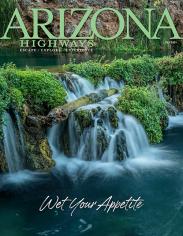A museum show is part storytelling and part conversation. At least, that’s how Emilia Mickevicius sees it. And curating one is a bit like planning a dinner party.
Take, for example, a gallery she recently curated for the San Francisco Museum of Modern Art. Mickevicius began with the work of photographer Chanell Stone, the event’s “honored guest.” Then, she imagined the photographers from history with whom she’d love to see Stone in conversation.
Now, Mickevicius will be putting that imagination to work for two storied Arizona institutions: the University of Arizona’s Center for Creative Photography, and the Phoenix Art Museum. An art historian with a specialty in 20th century American photography, Mickevicius will be based primarily at the CCP, where she’ll curate exhibitions from the center’s extensive collections for the museum’s Doris and John Norton Gallery. (That’s where she’s pictured in this photo.)
When Mickevicius was growing up in Wisconsin, her parents kept a basket of Arizona Highways issues in the living room, and the family made a pilgrimage to Tucson every spring. Later, as an undergraduate at the University of Chicago, Mickevicius studied Arizona’s deserts, braving the June heat at Chiricahua and Organ Pipe Cactus national monuments to conduct a botanical field study.
As for her professional qualifications, it’s hard to imagine a better fit. “I have been in love with photography for basically all my life,” she says. “My dad gave me a film camera when I was maybe 9 or 10. I photographed for my high school yearbook and was the photography editor for a magazine in college. But it was really taking a class for my art history major that sparked my interest in photographic history.”
The professor opened with a question: “What is a photograph?” Mickevicius recalls: “People started throwing out answers like ‘It’s a picture of reality,’ and he would say, ‘Well, what do you mean by that?’ [Or] ‘It captures the visible world,’ and he was like, ‘What do you mean by “capture”?’… And when we really unpacked it, it was like, oh, wow — this medium is unlike any other, because of its relation to truth and reality in our society and how people interpret those things.”
An internship at the Art Institute of Chicago introduced Mickevicius to curatorial work, which involves caring for museum collections and staging exhibitions. “That was so appealing for me,” she says — “the idea you could make a living just getting to think and write and talk about photographs.”
Mickevicius first visited the CCP while researching her bachelor’s thesis on photographer Paul Strand. She returned twice more for work on her doctoral dissertation, for Brown University, on the 1975 photographic landscape exhibition New Topographics. (Originally held at the George Eastman House in Rochester, New York, the show was restaged at the CCP in 2010.) And her graduate academic advisor was former CCP Director Douglas Nickel — and, like Nickel, Mickevicius came to the CCP from SFMOMA, where she worked as a curatorial associate in photography.
In curating shows, Mickevicius tries to appeal to people with a wide range of experiences. For example, she might group photographs that resonate for her, then trust that viewers will make their own connections. And she’s excited by the storytelling potential in the CCP’s extensive collections. With correspondence, negatives, and objects such as cameras and typewriters — and even a graffiti-covered locker that once belonged to photojournalist W. Eugene Smith — the collections offer insight into the artists’ lives, influences and work processes.
Drawing from all of that, Mickevicius hopes to place the canonical 20th century photographers in the CCP’s collections in conversation with contemporary artists, especially those who haven’t been extensively studied. The center’s acquisition priorities in recent years have set her up for success in that regard, she says, but it’s an ongoing process — and there can be a gap between “the conversations you want to be having in your galleries and the objects you have at your disposal to tell those stories.”
To bridge that gap, Mickevicius and her colleagues will continue to build relationships with emerging artists, particularly photographers of color and those from marginalized communities, and keep those artists on the radar of colleagues and collectors. The goal is not only to support the artists and facilitate the recognition they deserve, but also to create the conditions for their work to be added to museum collections.
Those values are just some of the reasons the CCP’s chief curator, Rebecca Senf, is happy to have Mickevicius join her team. “She has limitless enthusiasm for the makers, for the artworks, for the way museums bring these things together and convey them to audiences,” Senf says. “Already, she’s telling me about artists I don’t know about that are interesting and relevant for the center’s collection. She’s another set of eyes and ears in the world, another antenna picking up ideas or cultural trends … and that’s what’s really exciting.”

